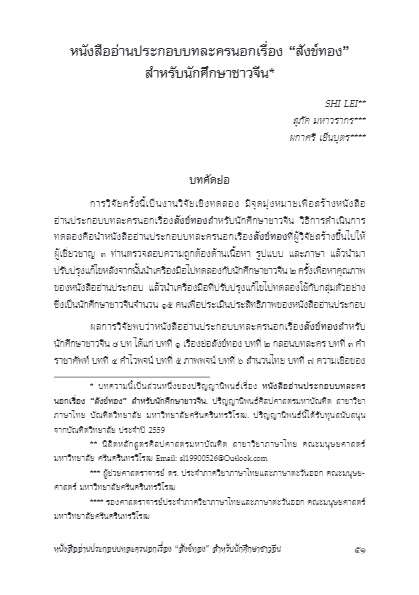SHI LEI, สุภัค มหาวรากร และ ผกาศรี เย็นบุตร
บทคัดย่อ
การวิจัยครั้งนี้เป็นงานวิจัยเชิงทดลอง มีจุดมุ่งหมายเพื่อสร้างหนังสืออ่านประกอบบทละครนอกเรื่องสังข์ทองสำหรับนักศึกษาชาวจีน วิธีการดำเนินการทดลองคือนำหนังสืออ่านประกอบบทละครนอกเรื่องสังข์ทองที่ผู้วิจัยสร้างขึ้นไปให้ผู้เชี่ยวชาญ 3 ท่านตรวจสอบความถูกต้องด้านเนื้อหา รูปแบบ และภาษา แล้วนำมาปรับปรุงแก้ไขหลังจากนั้นนำเครื่องมือไปทดลองกับนักศึกษาชาวจีน 2 ครั้งเพื่อหาคุณภาพของหนังสืออ่านประกอบ แล้วนำเครื่องมือที่ปรับปรุงแก้ไขไปทดลองใช้กับกลุ่มตัวอย่างซึ่งเป็นนักศึกษาชาวจีนจำนวน 15 คน เพื่อประเมินประสิทธิภาพของหนังสืออ่านประกอบ
ผลการวิจัยพบว่าหนังสืออ่านประกอบบทละครนอกเรื่องสังข์ทองสำหรับนักศึกษาชาวจีน 8 บท ได้แก่ บทที่ 1 เรื่องย่อสังข์ทอง บทที่ 2 กลอนบทละคร บทที่ 3 คำราชาศัพท์ บทที่ 4 คำไวพจน์ บทที่ 5 ภาพพจน์ บทที่ 6 สำนวนไทย บทที่ 7 ความเชื่อของคนไทย และบทที่ 8 เกร็ดความรู้ มีประสิทธิภาพ 88.40/86.10 ผ่านเกณฑ์ที่กำหนด และมีค่าดัชนีประสิทธิผล 0.75 แสดงให้เห็นว่าหนังสืออ่านประกอบบทละครนอกเรื่องสังข์ทองมีประสิทธิภาพและได้เสริมความรู้ ความเข้าใจ สติปัญญา ขยายประสบการณ์ ด้วยเนื้อหาที่เข้าใจง่าย นักศึกษาชาวจีนสามารถเรียนรู้เรื่องราวต่าง ๆ ได้ด้วยตนเอง ส่วนแบบประเมินความพึงพอใจสำหรับนักศึกษาในการใช้หนังสืออ่านประกอบมีคะแนนเฉลี่ย 4.38 แสดงว่านักศึกษาพอใจหนังสืออ่านประกอบบทละครนอกเรื่องสังข์ทองสำหรับนักศึกษาชาวจีน
หนังสืออ่านประกอบบทละครนอกเรื่องสังข์ทองสำหรับนักศึกษาชาวจีนที่ผู้วิจัยสร้างขึ้น สามารถเสริมความรู้เกี่ยวกับวัฒนธรรม คติสอนใจ วิถีชีวิต ความเชื่อของคนไทย อีกทั้งฝึกนิสัยรักการอ่านและการค้นคว้าด้วยตนเองรวมทั้งเป็นแนวทางให้ครูชาวจีนสามารถนำไปใช้ในการสอนวรรณคดีไทยเรื่องอื่น ๆ ได้อย่างมีประสิทธิภาพ การสร้างหนังสืออ่านประกอบบทละครนอกเรื่องสังข์ทองในครั้งนี้นับเป็นการเผยแพร่
วรรณคดีไทยให้ชาวจีนได้รู้จักมากขึ้นอีกด้วย
คำสำคัญ : สังข์ทอง, หนังสืออ่านประกอบ, นักศึกษาจีน
(ตีพิมพ์ใน วารสารไทยศึกษา ปีที่ 13 ฉบับที่ 2 (กรกฎาคม – ธันวาคม 2560) หน้า 51-72)
Supplementary Reading Book of Lakhon Nok “Sang Thong” for Chinese Students
SHI LEI, Supak Mahavarakorn and Phakasri Yenbutra
Abstract
This study is an experimental research project with the aim of creating a supplementary reading book of the lakhon nok, “Sang Thong”, for Chinese students.The researcher studied the material and the research on Thai drama and literature with the aim of creating a supplementary reading book. Subsequently, the researcher wrote a supplementary reading book on “Sang Thong” for Chinese students. The researcher sent the supplementary reading book to three experts to verify the accuracy of the content, form and language. Then, two experiments with Chinese students were conducted to verify the quality of the supplementary reading book. Upon completion of the book, an experiment with fifteen Chinese students was conducted in order to establish its effectiveness. The supplementary reading book of “Sang Thong” for Chinese students consists of eight chapters: Chapter 1: Synopsis of “Sang Thong”; Chapter 2: Drama in verse; Chapter 3: Royal words; Chapter 4: Synonyms; Chapter 5: Figures of speech; Chapter 6: Thai idioms; Chapter 7: The beliefs of Thai people; and Chapter 8: Tips about Thai literature. This book was found to be effective at the level of 88.40/86.10 and the progress of the students after using the supplementary reading book was at a level of 0.75. This result demonstrates that the supplementary reading book can help Chinese students develop their knowledge, understanding, wisdom and experience with the basic content. The assessment of the satisfaction levels of the students with the supplementary reading book had an average of 4.38 points, indicating that the students were satisfied with the supplementary reading book of “Sang Thong”.
This supplementary reading book of “Sang Thong” for Chinese students can enhance the knowledge of these students about Thai culture, traditions, beliefs, the Thai way of life, and also can cultivate the interest of the students in terms of their level of interest with regard to their reading and self-study abilities. The Chinese teachers also found this way of teaching Thai literature was more effective.
Keywords : Sang Thong; supplementary reading book; Chinese students
(Published in Journal of Thai Studies Volume 13 Number 2 (July – December 2017) Page 51-72)
บทความ / Full Text : Download
